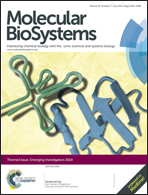Quantitative proteomic analysis reveals mitochondrial protein changes in MPP+-induced neuronal cells†
Abstract
Parkinson's disease (PD) is a common neurodegenerative disorder pathologically characterized by the loss of dopaminergic neurons in the substantia nigra pars compacta. To further explore potential functional mechanisms of PD, we performed a comparative proteomic analysis using stable isotope labeling with amino acids in cell culture (SILAC) combined with nano-LC tandem mass spectrometry (nano-LC MS). In total, 1740 proteins were identified in MPP+-treated SH-SY5Y cells. Our comparative proteomic analysis indicated that a total of 39 proteins were differentially expressed in SH-SY5Y cells responding to MPP+ treatment. Of these, 14 altered proteins were clustered in the mitochondria, 5 proteins were already reported as related to PD, and the remaining proteins were newly identified in this study. Together, our data further define that the mitochondria play an important role in regulating PD through multiple and complex mechanisms and provide new insights into the functional contribution of mitochondrial proteins in PD.


 Please wait while we load your content...
Please wait while we load your content...